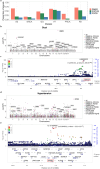FABIO: TWAS fine-mapping to prioritize causal genes for binary traits
- PMID: 39621803
- PMCID: PMC11649093
- DOI: 10.1371/journal.pgen.1011503
FABIO: TWAS fine-mapping to prioritize causal genes for binary traits
Abstract
Transcriptome-wide association studies (TWAS) have emerged as a powerful tool for identifying gene-trait associations by integrating gene expression mapping studies with genome-wide association studies (GWAS). While most existing TWAS approaches focus on marginal analyses through examining one gene at a time, recent developments in TWAS fine-mapping methods enable the joint modeling of multiple genes to refine the identification of potentially causal ones. However, these fine-mapping methods have primarily focused on modeling quantitative traits and examining local genomic regions, leading to potentially suboptimal performance. Here, we present FABIO, a TWAS fine-mapping method specifically designed for binary traits that is capable of modeling all genes jointly on an entire chromosome. FABIO employs a probit model to directly link the genetically regulated expression (GReX) of genes to binary outcomes while taking into account the GReX correlation among all genes residing on a chromosome. As a result, FABIO effectively controls false discoveries while offering substantial power gains over existing TWAS fine-mapping approaches. We performed extensive simulations to evaluate the performance of FABIO and applied it for in-depth analyses of six binary disease traits in the UK Biobank. In the real datasets, FABIO significantly reduced the size of the causal gene sets by 27.9%-36.9% over existing approaches across traits. Leveraging its improved power, FABIO successfully prioritized multiple potentially causal genes associated with the diseases, including GATA3 for asthma, ABCG2 for gout, and SH2B3 for hypertension. Overall, FABIO represents an effective tool for TWAS fine-mapping of disease traits.
Copyright: © 2024 Zhang et al. This is an open access article distributed under the terms of the Creative Commons Attribution License, which permits unrestricted use, distribution, and reproduction in any medium, provided the original author and source are credited.
Conflict of interest statement
I have read the journal’s policy and the authors of this manuscript have the following competing interests: L.C.T has received support from Galderma and Janssen.
Figures




Similar articles
-
Conditional transcriptome-wide association study for fine-mapping candidate causal genes.Nat Genet. 2024 Feb;56(2):348-356. doi: 10.1038/s41588-023-01645-y. Epub 2024 Jan 26. Nat Genet. 2024. PMID: 38279040
-
Leveraging expression from multiple tissues using sparse canonical correlation analysis and aggregate tests improves the power of transcriptome-wide association studies.PLoS Genet. 2021 Apr 8;17(4):e1008973. doi: 10.1371/journal.pgen.1008973. eCollection 2021 Apr. PLoS Genet. 2021. PMID: 33831007 Free PMC article.
-
A large-scale transcriptome-wide association study (TWAS) of 10 blood cell phenotypes reveals complexities of TWAS fine-mapping.Genet Epidemiol. 2022 Feb;46(1):3-16. doi: 10.1002/gepi.22436. Epub 2021 Nov 15. Genet Epidemiol. 2022. PMID: 34779012 Free PMC article.
-
From GWAS to Gene: Transcriptome-Wide Association Studies and Other Methods to Functionally Understand GWAS Discoveries.Front Genet. 2021 Sep 30;12:713230. doi: 10.3389/fgene.2021.713230. eCollection 2021. Front Genet. 2021. PMID: 34659337 Free PMC article. Review.
-
Opportunities and challenges for transcriptome-wide association studies.Nat Genet. 2019 Apr;51(4):592-599. doi: 10.1038/s41588-019-0385-z. Epub 2019 Mar 29. Nat Genet. 2019. PMID: 30926968 Free PMC article. Review.
Cited by
-
The integration of genome-wide and transcriptome-wide association studies in neurodegenerative diseases: opportunities, challenges, and current methodological innovations.Brief Bioinform. 2025 Jul 2;26(4):bbaf350. doi: 10.1093/bib/bbaf350. Brief Bioinform. 2025. PMID: 40694035 Free PMC article. Review.
-
Towards improved fine-mapping of candidate causal variants.Nat Rev Genet. 2025 Jul 28. doi: 10.1038/s41576-025-00869-4. Online ahead of print. Nat Rev Genet. 2025. PMID: 40721533 Review.
References
MeSH terms
Substances
Grants and funding
LinkOut - more resources
Full Text Sources
Research Materials

